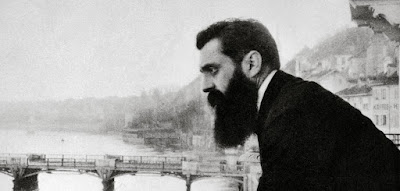The language fascinated me, and last Monday, I had the rare chance to listen to a talk by a real expert, Ruben Frankenstein, who is a Lecturer of Hebrew and Hebrew literature at the University of Freiburg.
He held his talk in the framework of the Jewish Cultural Days at the lecture hall of Freiburg's new synagogue.
Given the present situation in the Near East, security measures have been stepped up. Due to the beeping of the metal detector all over my body, I was thoroughly groped before being admitted to the lecture hall.
Yiddish (יידיש) is an approximately thousand-year-old West Germanic language that originated from Middle High German and was spoken by Ashkenazi Jews throughout much of Europe. It is written from right to left with Hebrew letters. Because of its wide distribution, Yiddish contains many Hebrew-Aramaic, Slavic, and Romanic components.
The etymology of the word is interesting. The Americans called the language of the Jewish immigrants Yiddish, derived from the German jüdisch. The "d" in English was doubled for clear hyphenation.
In German, the lingua franca of the Jews* was pejoratively called Judendeutsch, a taboo word after the Holocaust. Thus, people readily adopted the American term, Germanized as Jiddisch.
*referred to by them as mame-loschn (מאַמע-לשון), "mother tongue."

|
| Lecturing Ruben Frankenstein |
To form the past, Yiddish uses the Perfect tense rather than the Praeteritum, as is still the case in the Bavarian dialect. In addition, the Yiddish diminutive syllable is "-le," which corresponds to the German "-lein," while in North German, the appended "-chen" prevails.
Ruben Frankenstein gave three reasons why Yiddish is spoken today only by a few people in so-called language islands.
The first blow came with the slow emancipation of Jews in Germany, for which author Moses Mendelssohn, in the mid-19th century, insisted that for proper assimilation, the modern Jew must speak High German. Thus, the weight of spoken Yiddish shifted from Germany to Eastern Europe. The language integrating some Slavic words is called Eastern Yiddish.

|
| Theodor Herzl, dreaming of a Jewish state in Palestine |
The second reason for the decline of Yiddish was
Theodor Herzl's idea of a Jewish state in Palestine. Being an Austrian Jew,
he was an advocate of "German" to become the national language.
However, his concept excluded other Jews, such as the
Sephardim (Spanish or Portuguese Jews) and the Misrahim (Jews from Arab
countries or Iran and India).
However, the all-important reason for the decline of Yiddish was the Holocaust, in which the Jewish population was wiped out in large parts of Europe.
In the English Wikipedia, we read: In the 21st century, most people who speak (Eastern) Yiddish in their daily lives are Hasidim and other Haredim (strictly Orthodox Jews not accepting Hebrew as a secular language). Their numbers are estimated to be between 500,000 and one million in the United States, Canada, Europe, and Israel.
According to a lady in the audience, there is an active revival of Yiddish in the States. Let it be more than a flash in the pan.
So, the Zionist movement decided very early for Ivrit, the New Hebrew.
The linguistic creative
Eliezer ben Jehuda
pushed the revival of Hebrew, and the new form of the "sacred" language
became the lingua franca, the official language of the State of Israel.
However, the all-important reason for the decline of Yiddish was the Holocaust, in which the Jewish population was wiped out in large parts of Europe.
In the English Wikipedia, we read: In the 21st century, most people who speak (Eastern) Yiddish in their daily lives are Hasidim and other Haredim (strictly Orthodox Jews not accepting Hebrew as a secular language). Their numbers are estimated to be between 500,000 and one million in the United States, Canada, Europe, and Israel.
According to a lady in the audience, there is an active revival of Yiddish in the States. Let it be more than a flash in the pan.
*


No comments:
Post a Comment